2010 DODGE CHARGER check engine
[x] Cancel search: check enginePage 398 of 484
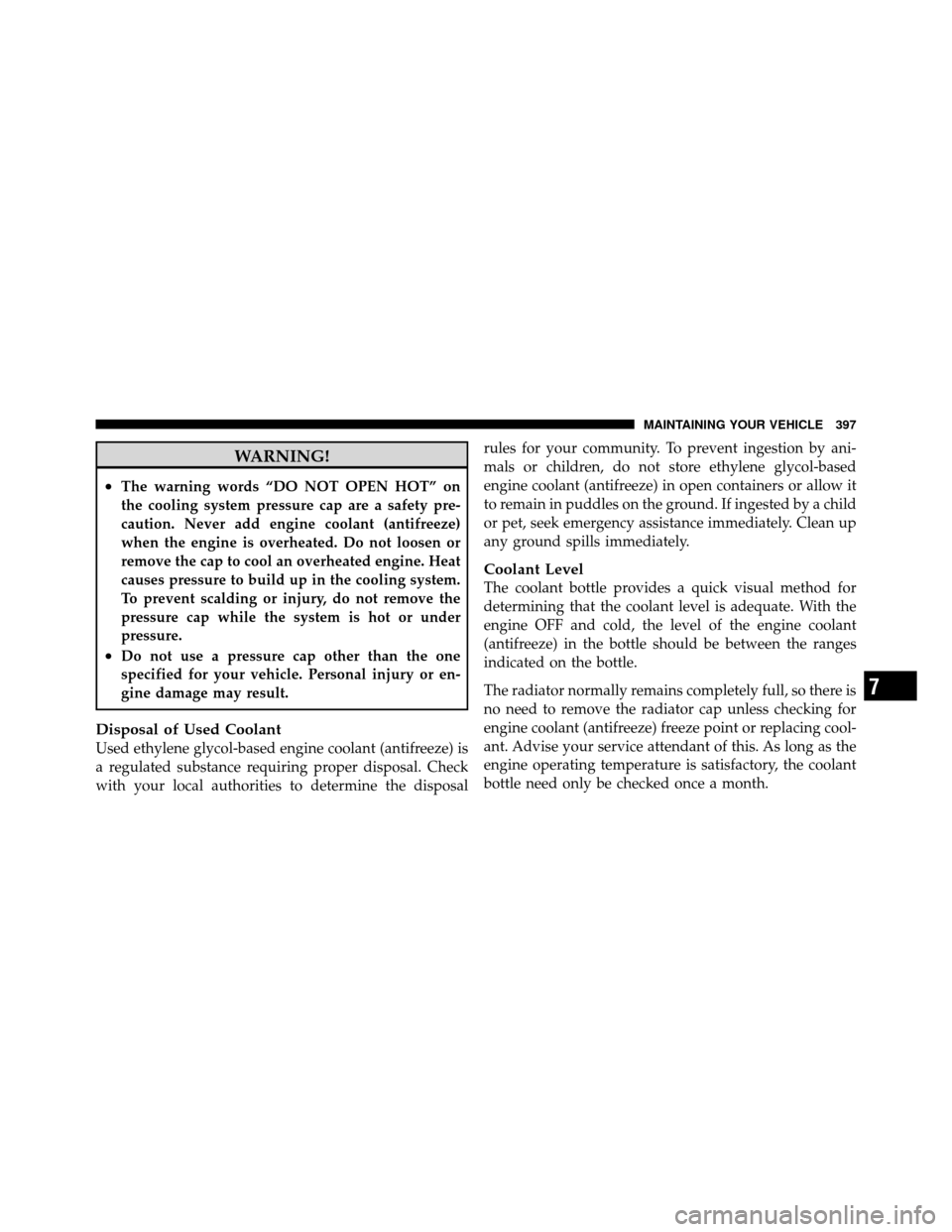
WARNING!
•The warning words “DO NOT OPEN HOT” on
the cooling system pressure cap are a safety pre-
caution. Never add engine coolant (antifreeze)
when the engine is overheated. Do not loosen or
remove the cap to cool an overheated engine. Heat
causes pressure to build up in the cooling system.
To prevent scalding or injury, do not remove the
pressure cap while the system is hot or under
pressure.
•Do not use a pressure cap other than the one
specified for your vehicle. Personal injury or en-
gine damage may result.
Disposal of Used Coolant
Used ethylene glycol-based engine coolant (antifreeze) is
a regulated substance requiring proper disposal. Check
with your local authorities to determine the disposalrules for your community. To prevent ingestion by ani-
mals or children, do not store ethylene glycol-based
engine coolant (antifreeze) in open containers or allow it
to remain in puddles on the ground. If ingested by a child
or pet, seek emergency assistance immediately. Clean up
any ground spills immediately.
Coolant Level
The coolant bottle provides a quick visual method for
determining that the coolant level is adequate. With the
engine OFF and cold, the level of the engine coolant
(antifreeze) in the bottle should be between the ranges
indicated on the bottle.
The radiator normally remains completely full, so there is
no need to remove the radiator cap unless checking for
engine coolant (antifreeze) freeze point or replacing cool-
ant. Advise your service attendant of this. As long as the
engine operating temperature is satisfactory, the coolant
bottle need only be checked once a month.
7
MAINTAINING YOUR VEHICLE 397
Page 399 of 484
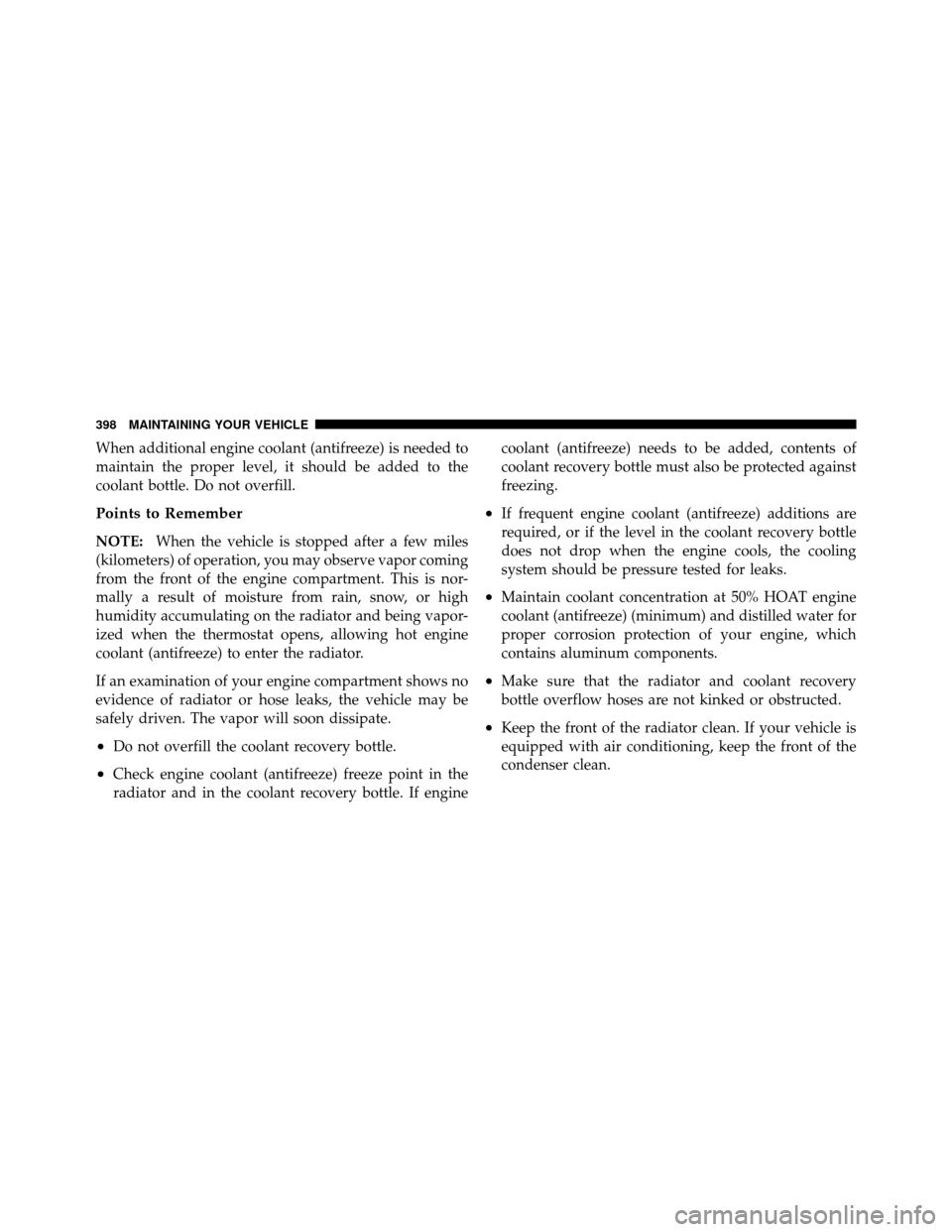
When additional engine coolant (antifreeze) is needed to
maintain the proper level, it should be added to the
coolant bottle. Do not overfill.
Points to Remember
NOTE:When the vehicle is stopped after a few miles
(kilometers) of operation, you may observe vapor coming
from the front of the engine compartment. This is nor-
mally a result of moisture from rain, snow, or high
humidity accumulating on the radiator and being vapor-
ized when the thermostat opens, allowing hot engine
coolant (antifreeze) to enter the radiator.
If an examination of your engine compartment shows no
evidence of radiator or hose leaks, the vehicle may be
safely driven. The vapor will soon dissipate.
•Do not overfill the coolant recovery bottle.
•Check engine coolant (antifreeze) freeze point in the
radiator and in the coolant recovery bottle. If engine coolant (antifreeze) needs to be added, contents of
coolant recovery bottle must also be protected against
freezing.
•If frequent engine coolant (antifreeze) additions are
required, or if the level in the coolant recovery bottle
does not drop when the engine cools, the cooling
system should be pressure tested for leaks.
•Maintain coolant concentration at 50% HOAT engine
coolant (antifreeze) (minimum) and distilled water for
proper corrosion protection of your engine, which
contains aluminum components.
•Make sure that the radiator and coolant recovery
bottle overflow hoses are not kinked or obstructed.
•Keep the front of the radiator clean. If your vehicle is
equipped with air conditioning, keep the front of the
condenser clean.
398 MAINTAINING YOUR VEHICLE
Page 434 of 484
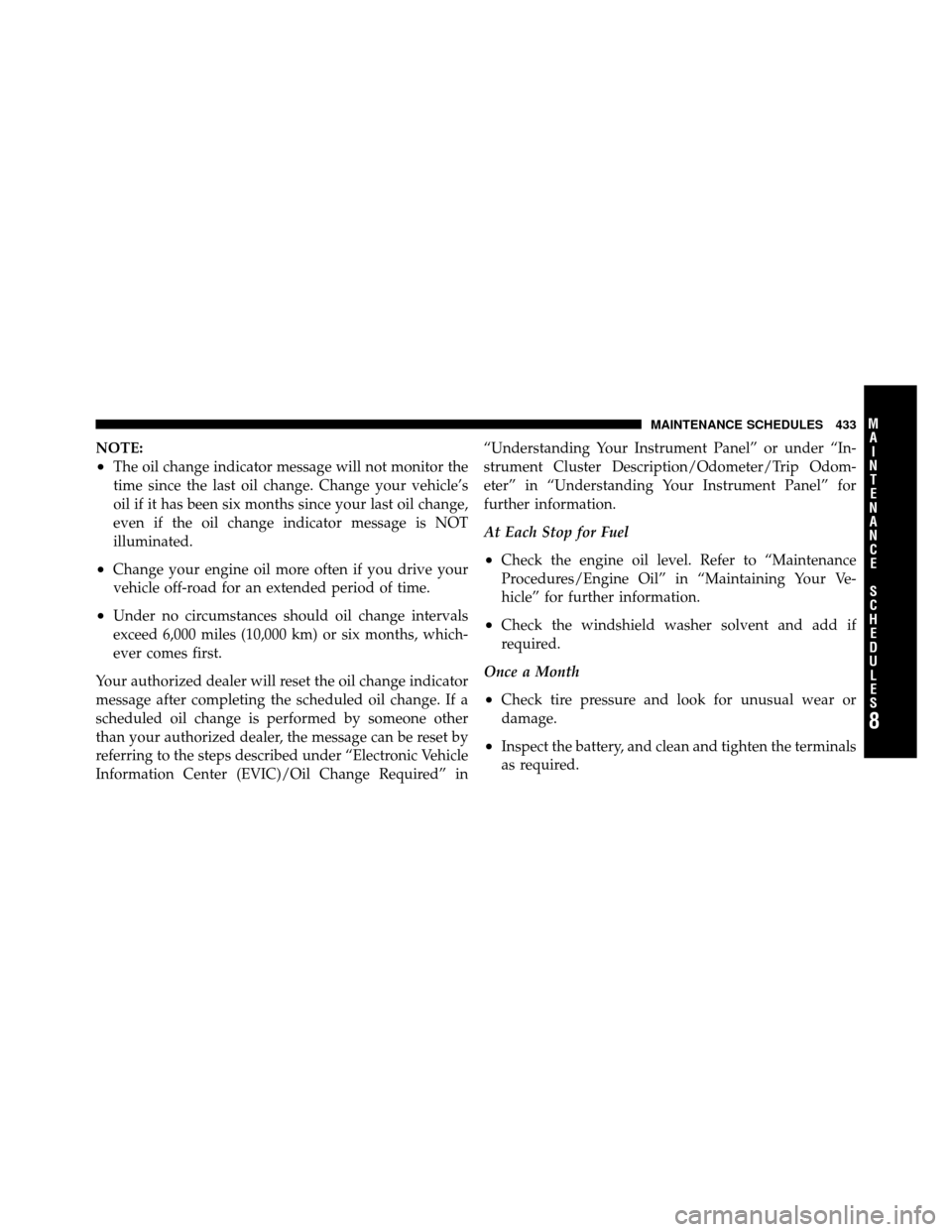
NOTE:
•The oil change indicator message will not monitor the
time since the last oil change. Change your vehicle’s
oil if it has been six months since your last oil change,
even if the oil change indicator message is NOT
illuminated.
•Change your engine oil more often if you drive your
vehicle off-road for an extended period of time.
•Under no circumstances should oil change intervals
exceed 6,000 miles (10,000 km) or six months, which-
ever comes first.
Your authorized dealer will reset the oil change indicator
message after completing the scheduled oil change. If a
scheduled oil change is performed by someone other
than your authorized dealer, the message can be reset by
referring to the steps described under “Electronic Vehicle
Information Center (EVIC)/Oil Change Required” in “Understanding Your Instrument Panel” or under “In-
strument Cluster Description/Odometer/Trip Odom-
eter” in “Understanding Your Instrument Panel” for
further information.
At Each Stop for Fuel
•Check the engine oil level. Refer to “Maintenance
Procedures/Engine Oil” in “Maintaining Your Ve-
hicle” for further information.
•Check the windshield washer solvent and add if
required.
Once a Month
•Check tire pressure and look for unusual wear or
damage.
•Inspect the battery, and clean and tighten the terminals
as required.
8
M A I
N T
E
N A
N CE
S
C
H E
D
U L
E
SMAINTENANCE SCHEDULES 433
Page 435 of 484
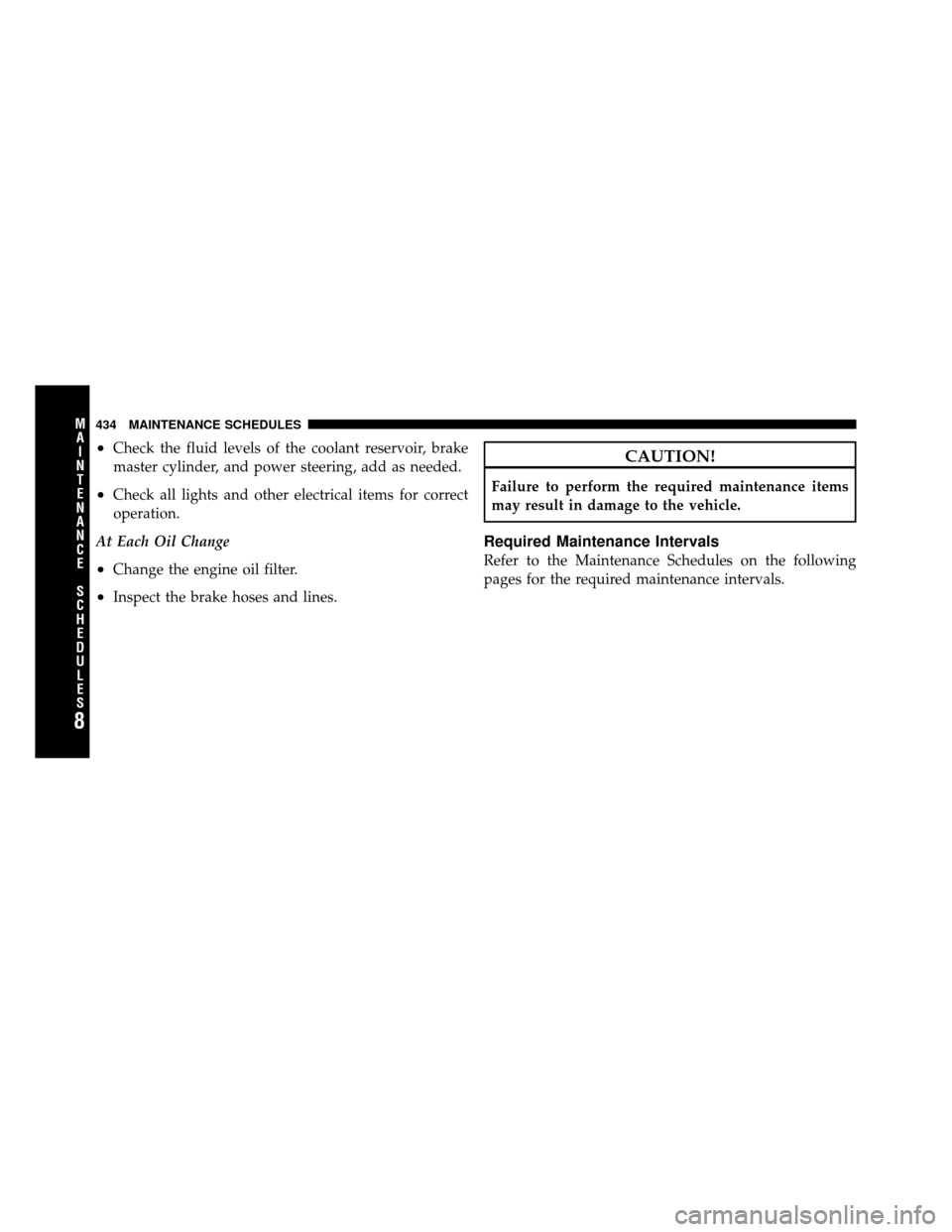
•Check the fluid levels of the coolant reservoir, brake
master cylinder, and power steering, add as needed.
•Check all lights and other electrical items for correct
operation.
At Each Oil Change
•Change the engine oil filter.
•Inspect the brake hoses and lines.
CAUTION!
Failure to perform the required maintenance items
may result in damage to the vehicle.
Required Maintenance Intervals
Refer to the Maintenance Schedules on the following
pages for the required maintenance intervals.
8
M A I
N T
E
N A
N CE
S
C
H E
D
U L
E
S434 MAINTENANCE SCHEDULES
Page 465 of 484
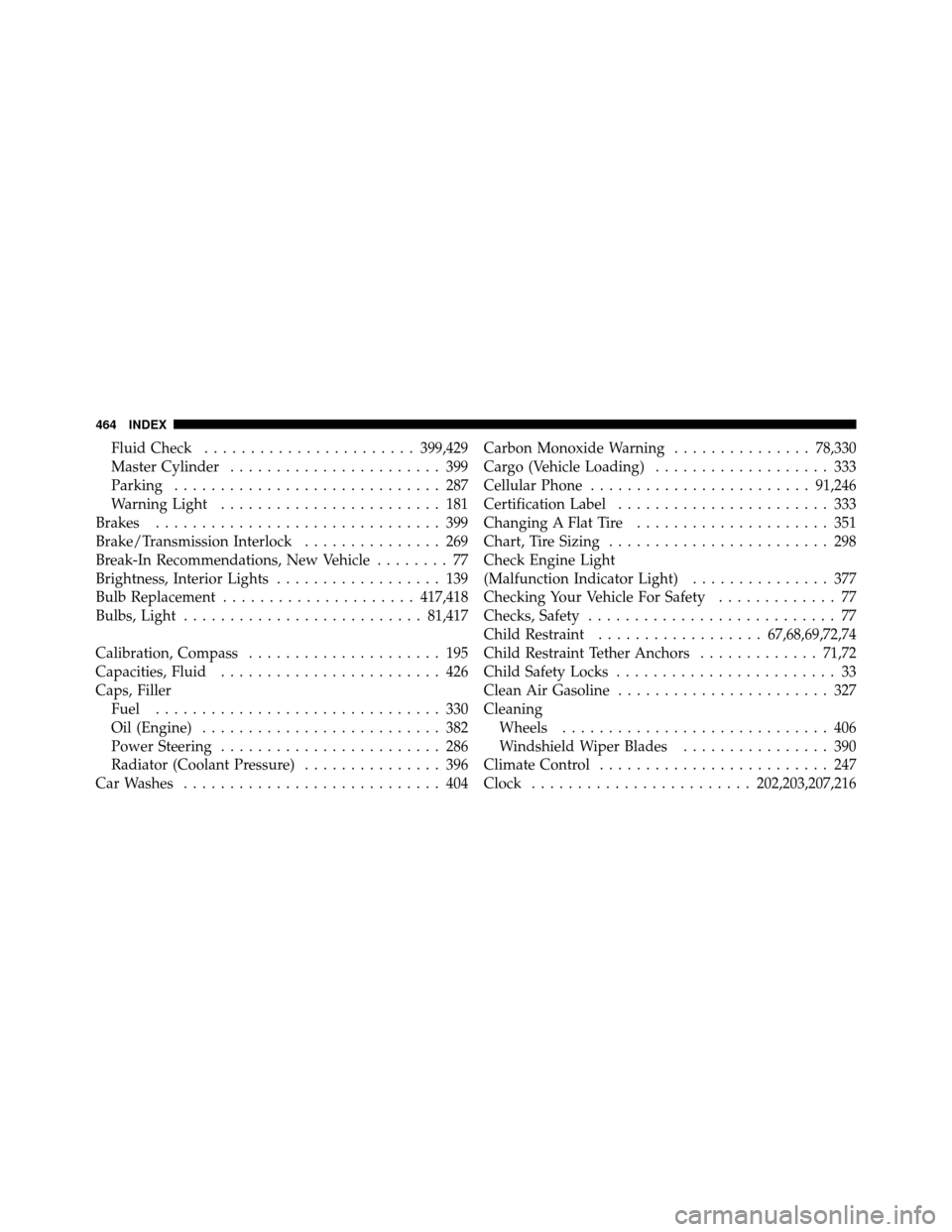
Fluid Check....................... 399,429
Master Cylinder ....................... 399
Parking ............................. 287
Warning Light ........................ 181
Brakes ............................... 399
Brake/Transmission Interlock ............... 269
Break-In Recommendations, New Vehicle ........ 77
Brightness, Interior Lights .................. 139
Bulb Replacement ..................... 417,418
Bulbs, Light .......................... 81,417
Calibration, Compass ..................... 195
Capacities, Fluid ........................ 426
Caps, Filler Fuel ............................... 330
Oil (Engine) .......................... 382
Power Steering ........................ 286
Radiator (Coolant Pressure) ............... 396
Car Washes ............................ 404 Carbon Monoxide Warning
...............78,330
Cargo (Vehicle Loading) ................... 333
Cellular Phone ........................ 91,246
Certification Label ....................... 333
Changing A Flat Tire ..................... 351
Chart, Tire Sizing ........................ 298
Check Engine Light
(Malfunction Indicator Light) ............... 377
Checking Your Vehicle For Safety ............. 77
Checks, Safety ........................... 77
Child Restraint .................. 67,68,69,72,74
Child Restraint Tether Anchors .............71,72
Child Safety Locks ........................ 33
Clean Air Gasoline ....................... 327
Cleaning Wheels ............................. 406
Windshield Wiper Blades ................ 390
Climate Control ......................... 247
Clock ........................ 202,203,207,216
464 INDEX
Page 468 of 484
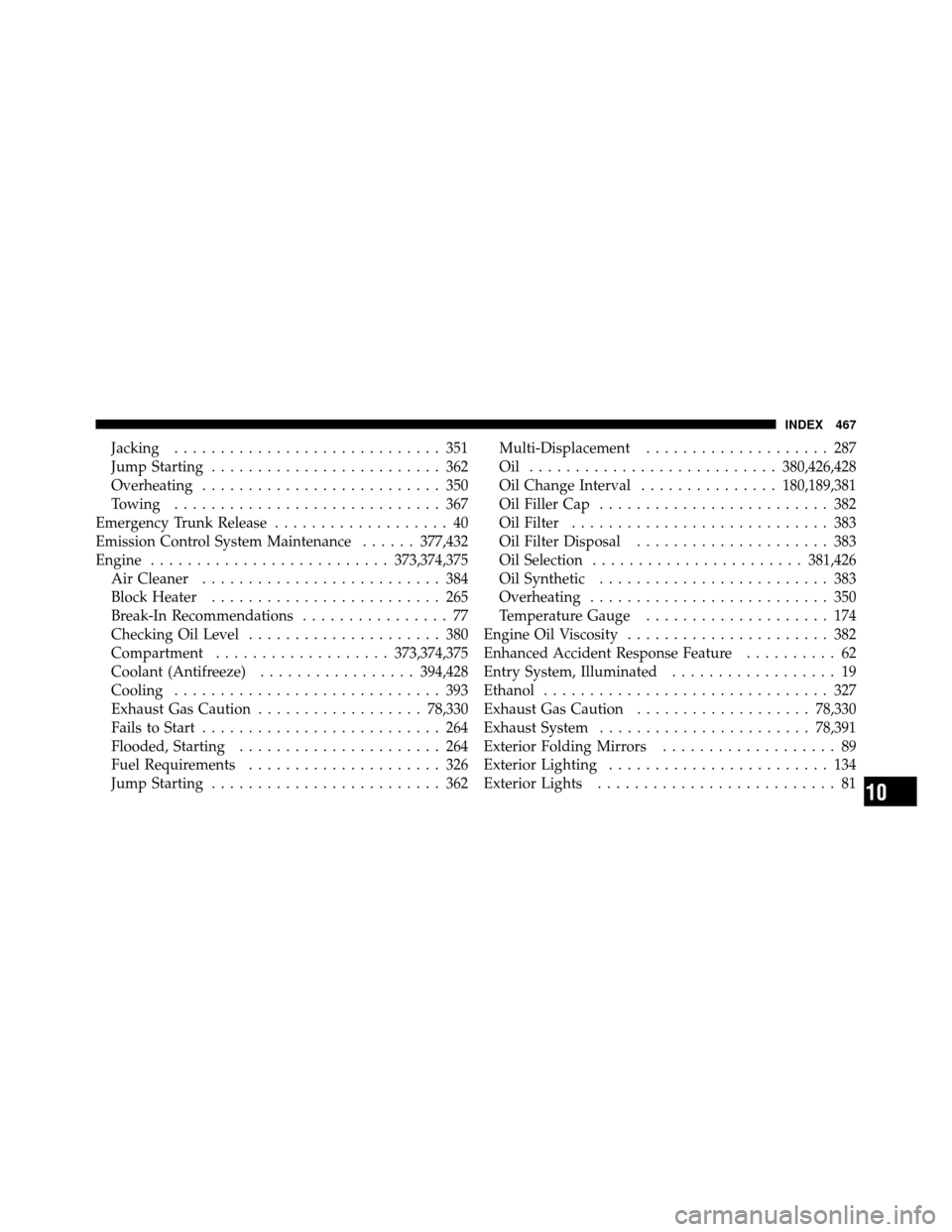
Jacking............................. 351
Jump Starting ......................... 362
Overheating .......................... 350
Towing ............................. 367
Emergency Trunk Release ................... 40
Emission Control System Maintenance ......377,432
Engine .......................... 373,374,375
Air Cleaner .......................... 384
Block Heater ......................... 265
Break-In Recommendations ................ 77
Checking Oil Level ..................... 380
Compartment ................... 373,374,375
Coolant (Antifreeze) ................. 394,428
Cooling ............................. 393
Exhaust Gas Caution .................. 78,330
Fails to Start .......................... 264
Flooded, Starting ...................... 264
Fuel Requirements ..................... 326
Jump Starting ......................... 362 Multi-Displacement
.................... 287
Oil ........................... 380,426,428
Oil Change Interval ...............180,189,381
Oil Filler Cap ......................... 382
Oil Filter ............................ 383
Oil Filter Disposal ..................... 383
Oil Selection ....................... 381,426
Oil Synthetic ......................... 383
Overheating .......................... 350
Temperature Gauge .................... 174
Engine Oil Viscosity ...................... 382
Enhanced Accident Response Feature .......... 62
Entry System, Illuminated .................. 19
Ethanol ............................... 327
Exhaust Gas Caution ................... 78,330
Exhaust System ....................... 78,391
Exterior Folding Mirrors ................... 89
Exterior Lighting ........................ 134
Exterior Lights .......................... 81
10
INDEX 467
Page 469 of 484
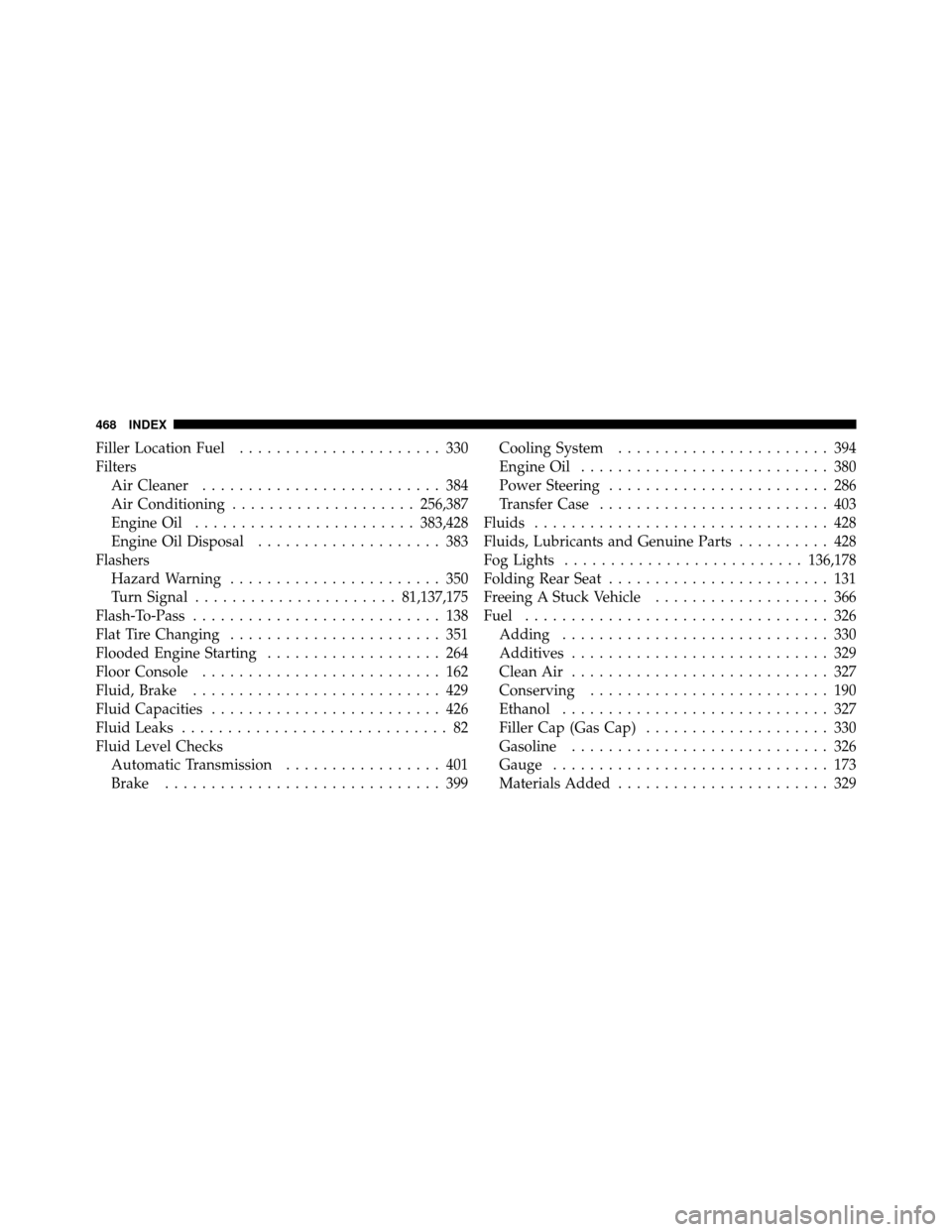
Filler Location Fuel...................... 330
Filters Air Cleaner .......................... 384
Air Conditioning .................... 256,387
Engine Oil ........................ 383,428
Engine Oil Disposal .................... 383
Flashers Hazard Warning ....................... 350
Turn Signal ...................... 81,137,175
Flash-To-Pass ........................... 138
Flat Tire Changing ....................... 351
Flooded Engine Starting ................... 264
Floor Console .......................... 162
Fluid, Brake ........................... 429
Fluid Capacities ......................... 426
Fluid Leaks ............................. 82
Fluid Level Checks Automatic Transmission ................. 401
Brake .............................. 399 Cooling System
....................... 394
Engine Oil ........................... 380
Power Steering ........................ 286
Transfer Case ......................... 403
Fluids ................................ 428
Fluids, Lubricants and Genuine Parts .......... 428
Fog Lights .......................... 136,178
Folding Rear Seat ........................ 131
Freeing A Stuck Vehicle ................... 366
Fuel ................................. 326
Adding ............................. 330
Additives ............................ 329
Clean Air ............................ 327
Conserving .......................... 190
Ethanol ............................. 327
Filler Cap (Gas Cap) .................... 330
Gasoline ............................ 326
Gauge .............................. 173
Materials Added ....................... 329
468 INDEX
Page 473 of 484
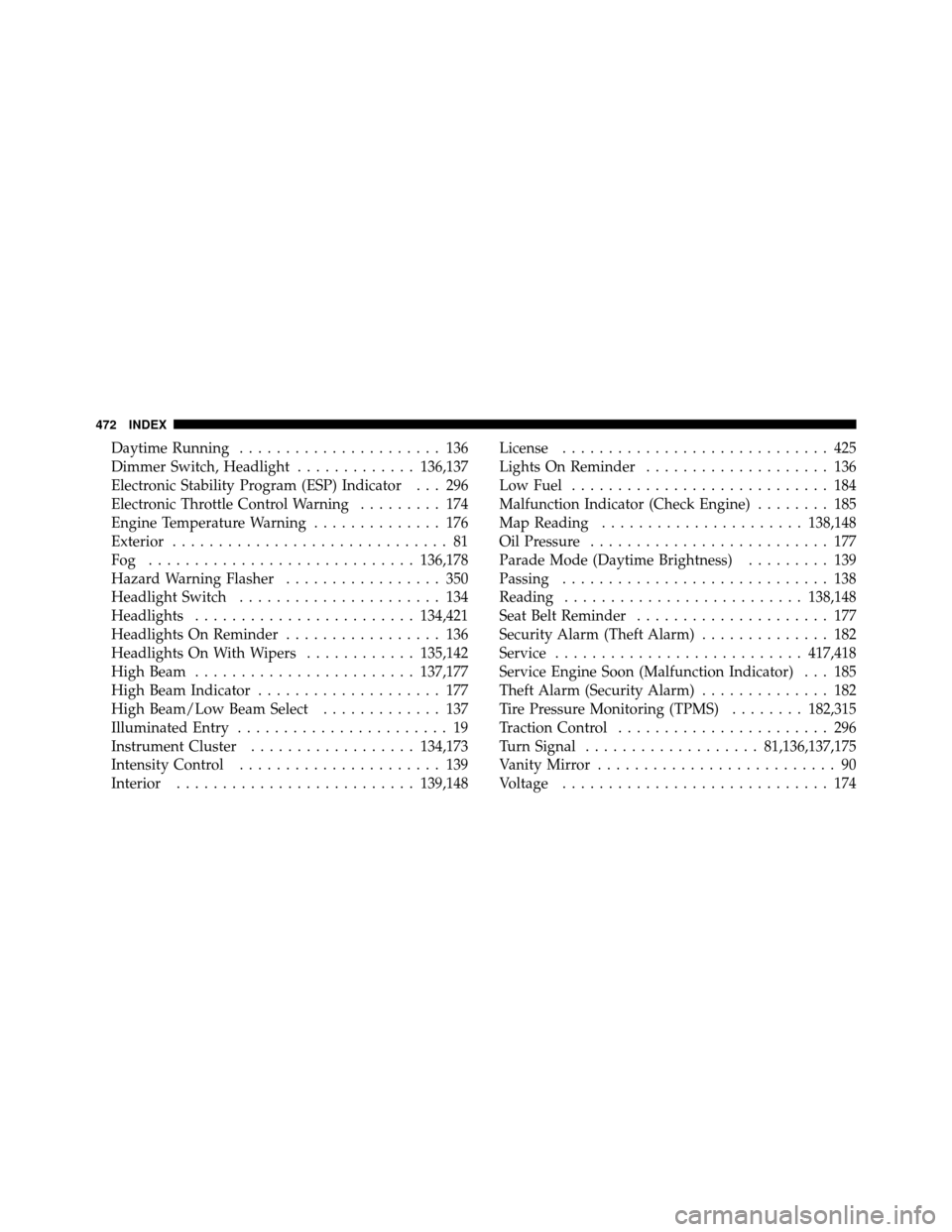
Daytime Running...................... 136
Dimmer Switch, Headlight .............136,137
Electronic Stability Program (ESP) Indicator . . . 296
Electronic Throttle Control Warning ......... 174
Engine Temperature Warning .............. 176
Exterior .............................. 81
Fog ............................. 136,178
Hazard Warning Flasher ................. 350
Headlight Switch ...................... 134
Headlights ........................ 134,421
Headlights On Reminder ................. 136
Headlights On With Wipers ............135,142
High Beam ........................ 137,177
High Beam Indicator .................... 177
High Beam/Low Beam Select ............. 137
Illuminated Entry ....................... 19
Instrument Cluster .................. 134,173
Intensity Control ...................... 139
Interior .......................... 139,148License
............................. 425
Lights On Reminder .................... 136
Low Fuel ............................ 184
Malfunction Indicator (Check Engine) ........ 185
Map Reading ...................... 138,148
Oil Pressure .......................... 177
Parade Mode (Daytime Brightness) ......... 139
Passing ............................. 138
Reading .......................... 138,148
Seat Belt Reminder ..................... 177
Security Alarm (Theft Alarm) .............. 182
Service ........................... 417,418
Service Engine Soon (Malfunction Indicator) . . . 185
Theft Alarm (Security Alarm) .............. 182
Tire Pressure Monitoring (TPMS) ........182,315
Traction Control ....................... 296
Turn Signal ................... 81,136,137,175
Vanity Mirror .......................... 90
Voltage ............................. 174
472 INDEX